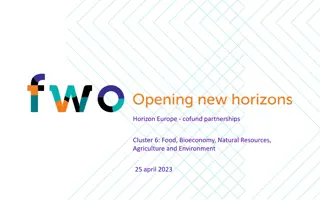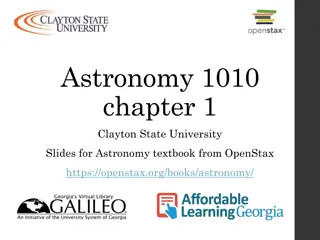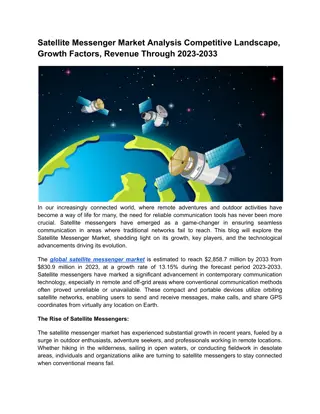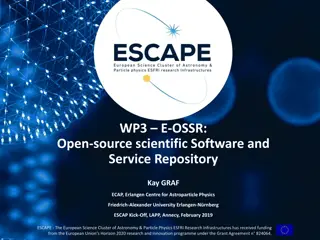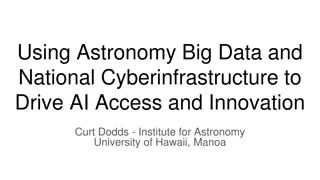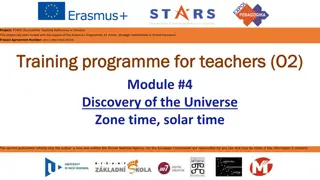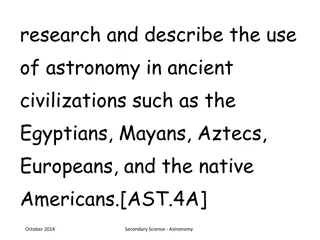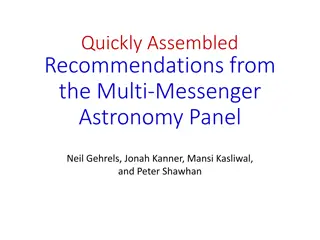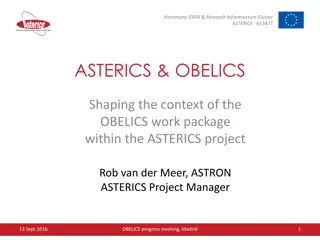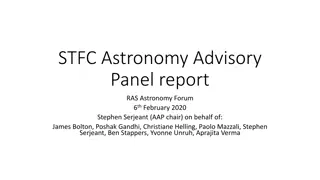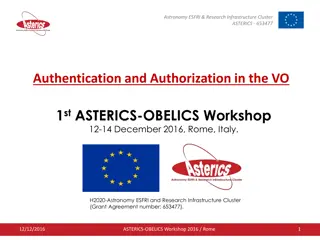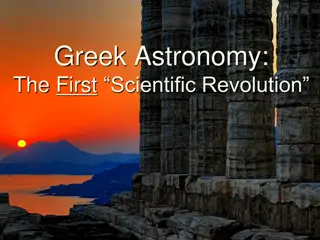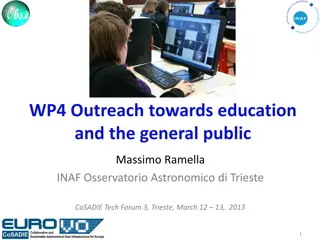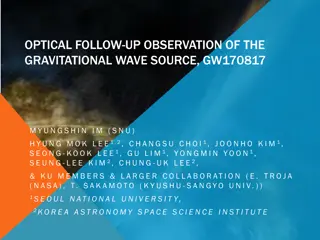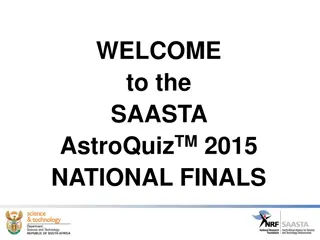Lessons Learned from EM Partnerships and Multi-Messenger Astronomy in O1
Reflecting on the successes and challenges encountered in O1, this presentation by Peter Shawhan explores the effectiveness of different collaborative approaches in multi-messenger astronomy. Key points include prior research activities, experiences with partner groups, the significance of MOUs, and strategies for enhancing communication and partnerships moving forward.
Download Presentation

Please find below an Image/Link to download the presentation.
The content on the website is provided AS IS for your information and personal use only. It may not be sold, licensed, or shared on other websites without obtaining consent from the author. Download presentation by click this link. If you encounter any issues during the download, it is possible that the publisher has removed the file from their server.
E N D
Presentation Transcript
EM Partnerships and Multi-Messenger Astronomy: What Did and Did Not Work in O1 Peter Shawhan (my views, but with some material from Marica Branchesi and Leo Singer) GW DAWN Meeting July 7, 2016 LIGO-G1601458-v2 GOES-8 image produced by M. Jentoft-Nilsen, F. Hasler, D. Chesters (NASA/Goddard) and T. Nielsen (Univ. of Hawaii)
))) Prior to O1 We had done several types of externally triggered GW searches and joint searches GRBs, magnetar flares using public (GCN) and private info High-energy neutrinos Radio transients [in progress] Supernovae [in progress] Pulsar glitch (Vela) Known pulsars Offline follow-up with satellite public /X-ray data [methods paper only] https://wiki.ligo.org/DAC/ExtCollabProposals CBC, Burst public public private private Burst private private CW CBC We had carried out an EM follow-up program during S6/VSR2+3 About a dozen partner groups, with a variety of communication protocols Sent alerts for 14 GW triggers; images obtained for 8, including Big Dog Image analysis results published in one big paper after a few years of work We had worked out a new framework for EM follow-up partnerships And enrolled 74 (!) partner groups under a standardized MOU 2
))) ExtTrig and Joint Analyses for O1 Partnerships continuing for access to private (and public) info GRBs: Interplanetary Network (IPN) detected bursts High-energy neutrinos: IceCube and ANTARES partnerships ongoing Radio transients: Continuing MOU with Parkes group (others?) Pulsars: Timing solutions from radio astronomers Sub-threshold analysis of Fermi GBM data around GW event candidates Relationships tend to persist Even when we ve reached formal end of MOU scope, in some cases Based on common interest and trust Expert guidance is helpful even in cases where data is publicly available For O1 and beyond, how strict should we be about MOUs? e.g.: Partners willing to continue informally with new data EM follow-up partners willing to supply information from their surveys for ExtTrig or joint analysis 3
))) EM Follow-up Project for O1 4
))) WWaDNW: Establishing Partners Good: Clear criteria for eligibility Got lots of applications, and the vast majority were eligible MOU conditions evidently did not scare away (many) potential partners Not Good: LV-EM Forum registration system needed lots of babysitting Failed to maintain regular communication (email, telecons) to have a meaningful Forum; the occasional messages were fairly impersonal Subscribing to private GCN Notices and Circulars were extra steps, overlooked by some partners, and often requiring iterating with Scott Barthelmy Outlook: Most active partners are set up now, but registration system and GCN distribution configuration still need manual intervention regularly. Trying to keep communication threads going in the Forum. 5
))) WWaDNW: Identifying GW Candidates Good: Low-latency analyses ran reliably and reported triggers Triggers were vetted quickly, and junk triggers were rejected Not Good: BBH deliberately excluded from low-latency CBC search at first GCN Retraction Notice mechanism was not fully implemented and tested, so it wasn t used during O1; made us extra cautious about sending alerts Outlook: Re-implementing software to be more robust, to deal better with multiple triggers from the same transient in the GW data, and for better monitoring. Would like to minimize alert latency by changing role of human vetting to be after sending the initial alert, and issue a retraction if needed. 6
))) WWaDNW: Communicating About Candidates Good: Standardized communication route with private GCN worked GraceDB access for partners and EM Bulletin Board worked pretty well Not Good: Alerts delayed by 1-2 days due to needing to seek approvals Some initial technical issues with private GCN Concerns about secrecy and protocol led to not sharing important info from the GW analysis until much later; led to inefficient observing and frustration; they did not feel like they were being treated as trusted partners Some confusion from providing multiple sky maps Outlook: O1 was all special cases; did not have a chance to settle into a routine. Will do better with experience and reduced pressure. Should agree on guidelines and then be able to act without bureaucratic overhead. Will provide more information in future: binary classification, distance. 7
))) WWaDNW: Follow-Up Observations Good: Much enthusiasm, even for the first event candidate! G184098 is an unvetted event of interest, There are important caveats associated to this event: * It occurred before the initiation of the planned observing run; * The detectors were not in their final O1 configuration; * Calibration is not finalized. In particular, calibration uncertainties may imply systematic errors in sky localization. Nevertheless, the trigger is of sufficient interest to present an important opportunity to exercise the EM follow-up process, Many astronomers willingly shared information about their observations Not Good: Edo Berger s frank assessment: the observations had shortcomings in terms of depth and/or sky coverage (Edo s GWPAW talk: https://emvogil-3.mit.edu/gwpaw2016/presentations/gwpaw2016_berger.key) Outlook Astronomers may become more selective about following up events 8
))) WWaDNW: Findings from Observations Good: The astronomers analyzed their own data and have written many papers Potential counterparts were considered rationally and published, or not Many optical transients were classified spectroscopically and dismissed Intriguing, controversial Fermi GBM weak transient was published and is being critiqued by the community Good give-and-take on optical transient PS15dpn with position-constrained parameter estimation from the GW data, firmly establishing that the redshift was inconsistent Established a streamlined partner paper check Formerly private GCN Circulars were added to the public GCN archive Not Good: Partner paper check turn-around was inconsistent in crush around Feb 11 Outlook: Will there be appropriate cases for true joint analyses & papers? 9
))) About Open Alerts LIGO+Virgo declared: the LSC and Virgo will begin releasing especially significant triggers promptly to the entire scientific community after the Collaborations have published papers (or a paper) about 4 GW events, at which time a detection rate can be reasonably estimated. The releases will be done as promptly as possible, within an hour of the detected transient if feasible. Initially, the released triggers will be those which have an estimated false alarm rate smaller than 1 per 100 years . Partners who have signed an MoU with the LSC and Virgo will have access to GW triggers with a lower significance threshold and/or lower latency Even MOU partners will be able to publish immediately, before any final word from the GW analysis General feeling that we should make this transition after O2 For concreteness more than technical reasons Discussion point: should/can we attempt to reserve the first NS binary event? Some will choose to continue as MOU partners, others will not ? 10
))) See Also From the March LVC meeting: LIGO-G1600630: Lessons learned from O1. How to do it better O2? LIGO-G1600674: EM Follow-up Plans for O2 From the May 12 LV-EM Forum telecon: LIGO-G1601066: Summary of O1 run LIGO-G1601085: O2 Lessons Learned From recent conferences: LIGO-G1601314: LIGO-Virgo Forum on Hunting GW Counterparts LIGO-G1601387: Marica s slides for the RICAP conference 11


